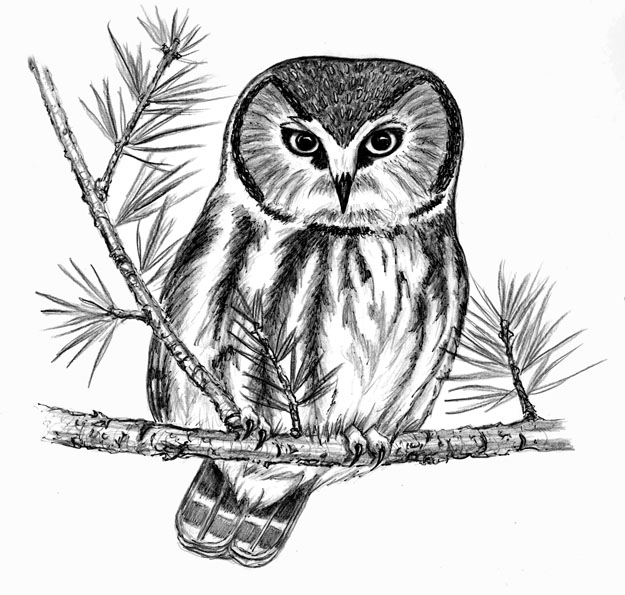
Dear Bird Folks,
For the past few nights I’ve heard a burglar alarm sounding in my neighborhood. The problem is, the alarm sound comes from a different location each night. Now I think we have some kind of owl calling in the area. Is there an owl that sounds like an alarm?
– Rodney, Spencer, IN
Maybe, Rodney,
What you are hearing may be an owl, but there is also the possibility that every house in your neighborhood was being burglarized. And instead of calling the cops, you grabbed a pen and started writing a note to me. While I try to answer questions as quickly as possible, it sometimes takes me a few weeks to respond. For the sake of your neighbors, I hope what you are hearing is an owl…or at least very, very slow burglars.
I think what you are hearing is the mechanical call of the Northern Saw-whet Owl. Birds use their songs and calls to communicate with each other, to attract a mate and to proclaim a territory. Their vocal skills range from beautiful (Wood Thrush), to harsh (Herring Gull), to haunting (Common Loon). Each species creates its own specialized call. Then there are the saw-whet owls. These birds are like the kids who never paid attention in school. While all of the other birds were working hard trying to develop their own distinctive sounds, the saw-whets were just staring out the window or doodling on their book covers. By the time they got around to choosing their own call, all of the good sounds were already taken. As a result, these owls ended up with a bland series of single notes. The call of the saw-whet owl is a steady stream of repeated notes that have a flat, emotionless quality to them. Many folks equate the call of this owl to the sound of a burglar alarm; and by “many,” I mean at least one person, from Spencer, Indiana.
I know a lot of birders who can attract birds simply by imitating certain calls. I’m not one of those birders. Every time I try to imitate a birdcall, the birds not only ignore me, but sometimes I can actually hear them laughing. But anyone with a pair of lips can do a dead-on impression of a saw-whet owl, even me. The saw-whet’s call is basically a series of very short, monotone, one-note whistles, which are repeated over and over and over, often lasting for several minutes or even hours. But what these birds lack in singing ability they make up for in cuteness. Saw-whets are not the intimidating nighttime predators that Great Horned Owls are. They are tiny and adorable, looking like the prize everyone wants to win at the arcade.
Smaller than a Baltimore Oriole and at 2.8 ounces, weighing less than a starling, saw-whets have a limited list of prey they can capture and consume. Their number one food of choice is mice. Most owls swallow their prey whole, but even tiny mice are too large for these diminutive birds. They must cut the mouse in two before swallowing each half. If prey is bountiful, the owls may only consume the front half of the mouse and not even bother to eat the back half. I don’t blame them for that. Eating a mouse’s head is creepy enough, but the idea of having a long tail sliding down my throat is totally gaggy.
Saw-whet owls can be found throughout much of North America, but I’d bet few folks have ever seen one. The birds hunt after dark and stay hidden in thick conifers during the day. However, they’ll readily come to nest boxes. Like other owls, saw-whets don’t build any kind of nest. They lay their eggs right on the floor of old woodpecker holes, particularly in holes made by flickers and Pileated Woodpeckers. If natural cavities are in short supply the owls may use a bird box. But don’t expect them to use a bluebird house. Saw-whets are small, but they need a fairly large, specifically designed birdhouse. During the nesting period the female does all of the incubating, while her mate remains outside and supplies her with yummy mouse halves. Mother saw-whets are excellent housekeepers. She quickly removes any inedible food scraps and flies out of the nest when she needs to cough up a pellet. (I seem to remember my mother doing the same thing.) But once the owlets start to grow, she no longer stays inside the nest cavity and that’s when all the tidiness ends. Like most kids, young owls are complete slobs. Without the old lady keeping things clean the nest quickly becomes loaded with poop, pellets, decaying animal parts and uneaten mouse tails. (Note to self: Never rent an apartment after a family of saw-whet owls has lived there.)
Like most birds, saw-whet owls produce an assortment of vocalizations. In addition to the burglar alarm call you were worried about, Rodney, they also produce a harsh, raspy call. It is this raspy call that early naturalists thought sounded like someone sharpening, or “whetting,” a saw blade, hence the name. (Early naturalists apparently had vivid imaginations.) Speaking of imagination, other regional names for this bird include Acadian owl, sparrow owl, farmland owl and Queen Charlotte owl. Wait. What? “Queen Charlotte owl”? That name sure sounds a little flamboyant for a bird of prey. Perhaps some owls have an unconventional lifestyle that we aren’t supposed to know about. Actually, the name refers to a subspecies of saw-whets that live off the coast of British Columbia, on the island of Queen Charlotte. At least, I hope that’s where the name comes from.